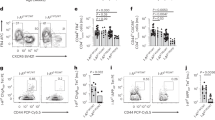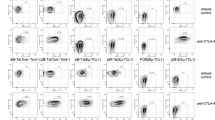Abstract
DURING cell differentiation in the thymus, self-reactive T cells can be generated. The majority of these seem to be deleted after intrathymic encounter with the relevant autoantigen1. As all self antigens are unlikely to be present in the thymus, some autoreactive T cells may escape censorship. Here we study the fate of these cells using transgenic mice expressing the class I molecule H–2Kb(Kb) in the insulin-producing β -cells of the pancreas2,3. These mice were crossed with mice transgenic for genes encoding a Kb-specific T-cell antigen receptor (TCR)4 which could be detected using a clonotype-specific monoclonal antibody5. Although T cells expressing the highest level of transgenic TCR were deleted intrathymi-cally in double-transgenic mice, Kb-specific T cells were detected in the periphery. These cells caused the rejection of Kb-expressing skin grafts, but ignored islet Kb antigens even after priming. But when double-transgenic mice were crossed with transgenic mice expressing the lymphokine interleukin-2 in the pancreatic β-cells6, there was a rapid onset of diabetes. These results indicate that autoreactive T cells that ignore self antigens may cause autoimmune diabetes when provided with exogenous 'help' in the form of interleukin-2.
This is a preview of subscription content, access via your institution
Access options
Subscribe to this journal
Receive 51 print issues and online access
$199.00 per year
only $3.90 per issue
Buy this article
- Purchase on SpringerLink
- Instant access to full article PDF
Prices may be subject to local taxes which are calculated during checkout
Similar content being viewed by others
References
von Boehmer, H. A. Rev. Immun. 8, 531–556 (1990).
Allison, J. et al. Nature 333, 529–533 (1988).
Morahan, G., Allison, J. & Miller, J. F. A. P. Nature 339, 622–624 (1989).
Schönrich, G. et al. Cell 65, 293–304 (1991).
Hua, C., Boyer, C., Buferne, M. & Schmitt-Verhulst, A.-M. J. Immun. 136, 1937–1944 (1986).
Allison, J., Malcolm, L., Chosich, N. & Miller, J. F. A. P. Eur. J. Immun. 22, 1115–1121 (1992).
Miller, J. F. A. P., Morahan, G., Allison, J. & Hoffmann, M. Immunol. Rev. 122, 103–116 (1991).
Miller, J. F. A. P., Morahan, G. & Allison, J. Cold Spring Harbor Symp. quant Biol. 54, 807–813 (1989).
Ohashi, P. S. et al. Cell 65, 305–317 (1991).
Oldstone, M. B. A., Nerenberg, M., Southern, P., Price, J. & Lewicki, H. Cell 65, 319–331 (1991).
Schönrich, G. et al. Int. Immun. 4, 581–590 (1992).
Morahan, G., Hoffmann, M. W. & Miller, J. F. A. P. Proc. natn. Acad. Sci. U.S.A. 88, 11421–11425 (1991).
Lo, D. et al. Eur. J. Immun. 22, 1013–1022 (1992).
Dennert, G., Hyman, R., Lesley, J. & Trowbridge, I. Cell Immun. 53, 350–364 (1980).
Author information
Authors and Affiliations
Rights and permissions
About this article
Cite this article
Heath, W., Allison, J., Hoffmann, M. et al. Autoimmune diabetes as a consequence of locally produced interleukin-2. Nature 359, 547–549 (1992). https://doi.org/10.1038/359547a0
Received:
Accepted:
Issue Date:
DOI: https://doi.org/10.1038/359547a0
This article is cited by
-
Rare phenotypes in the understanding of autoimmunity
Immunology & Cell Biology (2016)
-
Too dangerous to ignore: self‐tolerance and the control of ignorant autoreactive T cells
Immunology & Cell Biology (2008)
-
Satisfaction (not) guaranteed: re-evaluating the use of animal models of type 1 diabetes
Nature Reviews Immunology (2004)
-
Peripheral antigen-expressing cells in type 1 diabetes
Current Diabetes Reports (2004)
-
Promiscuous gene expression in medullary thymic epithelial cells mirrors the peripheral self
Nature Immunology (2001)



